 |
Forte di Belvedere
Florence, Italy
|
|
 |
Constructed: 1590-1595
Also known as: Fortezza di Santa Maria in San Giorgio del Belvedere
Used by: Florence, Italy
Conflicts in which it participated:
None
|
The Forte di Belvedere's guns were never fired in anger, but were rather used to alert Florence of the most important time of the day: Lunchtime!
Julius Caesar (100BC-44BC) founded a settlement called Fluentia betwixt the Mugnone and Arno Rivers, which was later renamed Florentia. Built as a home for veteran Roman soldiers, it was laid out, unsurprisingly, in the fashion of a military camp.
Caesar sure knew how to found a city, because within a thousand years or so, Florence had become one of the most populous, financially and culturally important cities in medieval Europe. |
 |
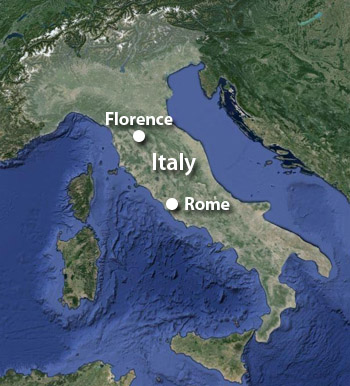 |
|
Though Florence was politically organized as a democracy, at the top of the heap was a slathering of well-to-do-families, of whom the Medci were the most slatherous of all. Beginning in the first half of the 15th century, banker Cosimo de' Medici (1389-1464) was "first among equals" in Florence, and his family more or less ruled Florence for the next couple of centuries. The Medici lent money to foreign kings, produced four Popes, and were lavish supporters of the arts: We can thank them for funding the creation of the piano and opera, for supporting many of the Renaissance-era artists who are remembered today, and, most importantly, they may have been responsible for the invention of the starfort!
|
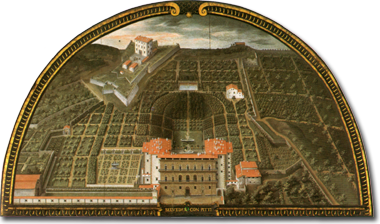 Palazzo Pitti and the Boboli Gardens by Iustus Van Utens (d. 1609), one of fourteen lunettes the Flemish artist painted of Medici villas at the end of the 16th century. You may note that the Forte di Belvedere juts its way aggressively into the scene at top left. |
 |
In 1487 Lorenzo de' Medici (1449-1492) directed that a fortification be built in Sarzana, just a bit northwest of Florence on Italy's western coast, to replace a 13th-century castle which he had recently caused to be destroyed through military action. The new fortification he invisaged would be defensible against the up-and-coming scourge of artillery, and the Fortezza di Sarzana was duly designed and built by his team of engineers. This Fortezza may or may not have been the very first example of bastioned fortification in the starfort style, but I'm pretty confident that it was one of the first. The starfort of our current interest, however, was built between 1590 and 1595 by Italian artist and engineer Bernardo Buontalenti (1531-1608) at the behest of Ferdinando I de' Medici (1549-1609). |
|
|
By this time the Medicis had progressed from being mere bankers to being Cardinals and Dukes and things, as befit their regal demeanor...and the current need for fortification was less a reaction to external threat than it was to local unrest. Florence was a riotous town, which had twice expelled the Medicis from power, only to see them reinstated thanks to their connections in Rome (the Pope owing them vast sums of money was an excellent political foot in the door). The Forte di Belvedere was thus fancied as more of a visually impressive, safe place to keep Medici possessions and persons than a classic military strongpoint.
|
The word belvedere translates as "beautiful view" and/or "lookout" in Italian. This is a fairly common name in English, so it initially struck me as an odd name indeed for an Italian starfort!
The hilltop upon which our Forte was built was identified as a strategic point by none other than Michelangelo (1475-1564), possibly the most famous artist in the history of art, who had been Florence's chief engineer of fortifications during the Siege of Florence (1529-1530).
|
 |
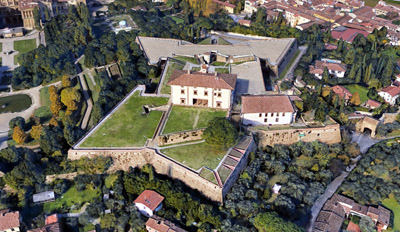 The Forte di Belvedere from the south. Thank you, Google Earth!!! The Forte di Belvedere from the south. Thank you, Google Earth!!! |
|
This siege resulted in the return of the Medici to Florence thanks to Holy Roman Emperor Charles V (1500-1558)'s Spanish troops, after those dirty Spaniards had sacked Rome for historical purposes (the sacking of Rome was a form of bi-centurial European sport for many centuries).
The Forte di Belvedere's most striking component is the blindingly white, three-story Belvedere Building, which has no military function: Let's put a big fat white target in the middle of our starfort! This structure was designed as a clear statement that this was a sumptuous Medici villa, albeit a particularly secure one: As this was an "urban fortress," it was imperative that it project enough wealth and fashion to make the neighbors jealous. This edifice's upper floors were only accessible by one narrow staircase, however, which would likely have been defensible to a degree.
|
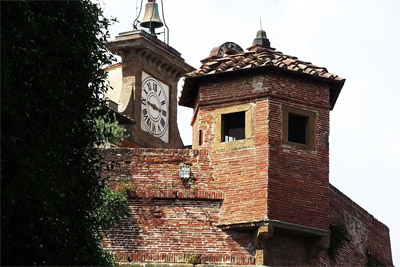
The Forte di Belvedere's only, from what I can tell, garita, with the clock atop the center villa's facade behind it. If a starfort didn't have garitas at every corner, generally they would be placed to keep watch in the direction from which trouble was expected to emanate...in this case it faces over the Arno River, into the city. |
 |
Since our Forte was really just intended to be a huge, marital platform for a lovely villa, extreme measures were taken to safeguard Medici riches. A crypt was built within a cave, at the bottom of a deep well, inside the fort's walls, where the Medici booty was stashed. The existence of this crypt was rumored for centuries, and was finally discovered "recently": "Various deadly traps connected to the opening device in case someone tried to force it" were unearthed by the no doubt delighted excavators. Only the penintent man will pass! These traps included arquebuses (matchlock long arms, or "hand cannons") which had somehow been primed to fire upon those illicitly entering the chamber; a means by which to flood the chamber from above so as to drown infiltrators; and the standard hidden pit filled with sharp pointy things.
|
|
|
The Forte di Belvedere's guns were never required for the defense of Medici gold, but a single gun was fired from the fort every day at noon. The residents of Florence good-naturedly named this il cannone delle pastasciutte, "the cannon of pastas."
The Medici had loads of villas from which to choose on a daily basis, and the one perched atop the Forte di Belvedere was likely a little difficult to get in and out of, so whichever Medici was the current Grand Duke only stayed therein during "unhealthy times," such as when things were looking rioty on the streets of Florence. Ferdinando I de' Medici (1549-1609), Grand Duke of Tuscany, remained in the Forte during a plague epidemic in 1600.
|
By the 18th century the Medici's power was on the wane, thanks to their dwindling fortune, Florence's dwindling population and a variety of non-dwindlous power plays betwixt Austria, Spain and Tuscany. Leopold II (1747-1792), Grand Duke of Tuscany, opened the Forte di Belvedere to the public of Florence for a period in the 1790's. How many died of arquebus wounds while trying to get at the Medici's stash, and more to the point, how long did those arquebus' matches remain lit? Unrecorded.
The Forte di Belvedere remained a military barracks until the mid-1950's. Following a reconstructive effort it was opened to the public in 1958.
|
 |
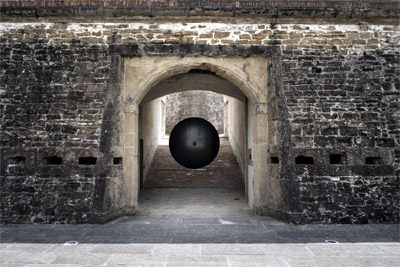 Since 2013 the Forte di Belvedere has been unnecessarily littered with the works of a variety of artists, such as this planet/gong/ellipse-thing blocking one of the forte's sacred passageways. Since 2013 the Forte di Belvedere has been unnecessarily littered with the works of a variety of artists, such as this planet/gong/ellipse-thing blocking one of the forte's sacred passageways. |
|
The 21st century has been an eventful one thus far for the Forte: In 2006 and again in 2008, visitors plummeted to their deaths from the fort's bastions. The Forte was closed in 2008 pending an investigation into these dreadful accidents, to see if the city of Florence was in any way responsible for the actions of two guys who dumbly fell off a starfort. I'm fairly certain that I've been to way more starforts than either of these guys, and I've managed to not fall off of any of them. Fortunately, the city was excused, and the Forte reopened in 2013.
|
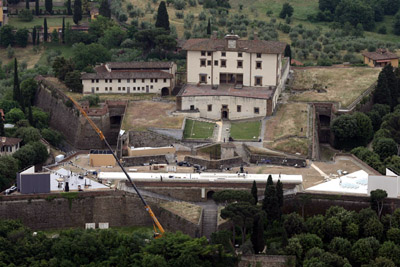
The Forte di Belvedere in a state of advanced preparation for 2014's royal wedding of Kim Kardashian to Kanye West. For all I know, maybe Kim and Kanye are huge starfort enthusiasts. |
 |
...just in time for mysteriously famous person Kim Kardashian ( 1980- ) and rapper Kanye West (1977- ) to get married in it! May of 2014 saw these nuptials undertaken, to great fanfare. No deaths were reported, either from falling, arquebus fire, or deadly falling arquebuses.
When the Forte reopened in 2013, it did so with an exhibition of Chinese artist Zhang Huan's work, sprinkled about the fort. Since then a variety of other artists have displayed objects at the fort. One could say things about not besmirching historic starforts with unnecessary modern trifles, but this is Italy (where art was invented), and one supposes that they may do what they wish with their starforts. |
|
|
Florence is well-supplied with starforts. In addition to the Forte di Belvedere is the Fortezza da Basso, a much more military-minded starfort than Belvedere; and the Abbazia di San Miniato al Monte, which is of course an abbey, not a starfort, but I'll be darned if that thing isn't a starfort! It seems unlikely that I will dedicate a whole page to either of them, so perhaps we'll just memorialize them here:
|
|
|
The Fortezza da Basso (which translates as "the fortress down low," assumedly referring to the fact that it was not built atop a hill of any sort, as were Florence's other starforts) was integrated with Florence's 14th-century city walls, and was initially surrounded by a moat. When Florence was named the new republic of Italy's capital city in 1865, however, those ancient walls were demolished. The Fortezza suddenly stood alone, and its moat was filled in.
The Fortezza was operated by the Italian military until 1967, after which it floated, free and purposeless, through time and space. It has recently been named as the seat of the Florentine Exhibition Center, and has since been undergoing a lengthy restoration process.
|
|
 |
Abbazia di San Miniato al MonteSaint Miniato was Florence's first martyr, beheaded during an anti-Christian beheading spree around the year 250AD, as approved by Roman Emperor Decius (201-251). Immediately following his beheading, Miniato proceeded, head in hand, across the Arno to the mountaintop of our present interest, where he existed for the next few centuries as an undead monster, frightening passersby with unpleasant gurgling noises. The gurgling noises were erased from the public memory, and a sanctuary was erected in his honor once he finally, mercifully, ceased to be.
Monks of the Benedictine order oversaw the construction of the present abbey, which began in 1018. Monks still live there today, producing liquers, honey and herbal teas which are sold nearby.
|
|
The reason that this abbey is lovingly surrounded by starfort walls and bastions has to do with our old friend Michelangelo, who was named Governor General over the city's fortifications during the Siege of Florence in 1530. Michaelangelo's ideas about fortification were every bit as innovative as his ideas about everything else, and he left behind starforty drawings of planned additions to Florence's walls...and it was he who designed the bastioned trace that protects this abbey today.
|
It was of course not to protect the abbey itself that starfort elements were built in this instance, but because the mountain to the top of which Miniato headlessly pranced is one of Florence's highest, and was identified as an excellent location for artillery...and even if one doesn't intend to place artillery at such a spot oneself, one would wish to prevent one's enemy from doing so.
Following the siege and the return of the Medici, Michelangelo went into hiding, logically fearing retribution for his role in the attempt to keep those Medici out. He escaped the city and made it to Venice, and was soon thereafter officially forgiven by Pope Clement VII 1478-1534), who recognized Michelangelo as "the only artist capable of giving shape to the dreams of glory of his dynasty."
|
 |
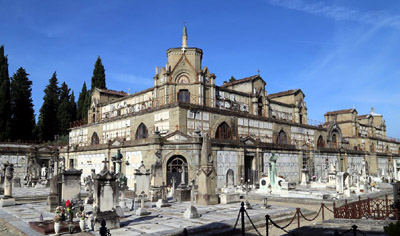 Unjustly, the only pictures of the Abbazia di San Miniato al Monte immediately available online are of the abbey, not its fortification. The abbey does indeed have many breathtaking aspects, but I think you'll agree that its immediate surrounding courtyard is a bit...untidy. Unjustly, the only pictures of the Abbazia di San Miniato al Monte immediately available online are of the abbey, not its fortification. The abbey does indeed have many breathtaking aspects, but I think you'll agree that its immediate surrounding courtyard is a bit...untidy. |
|
I will admit that I feel compelled to end with another joke about decapitated Saint Miniato, but I think we've pretty much played that one out, so the end.
|
|
|
|
|
|
 |




